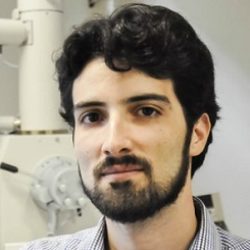
Publicações de Amauri Jardim
Vieira, Laís H. S.; Ramos, Maria K.; Schmidt, Ariane; Pereira, Amanda F.; Araújo, Bruno S.; Cordeiro, Carlos H. N.; Júnior, Francisco H. Soares; Paula, Amauri J.; Soares, João M.; Fechine, Pierre B. A.; Ghosh, Anupama; Filho, Antonio G. Souza; Zarbin, Aldo J. G.; Ferreira, Odair P. Thin films from agroindustrial waste via liquid/liquid interfacial route: a proposal for sustainable energy storage materials Journal Article Em: Carbon, vol. 239, 2025, ISSN: 0008-6223. Resumo | Links | BibTeX | Tags: Cala, Paula; Dariani, Guilherme; Veiga, Eduardo; Macedo, Pedro; Paula, Amauri J.; de Almeida, James M. Predictive Modeling of Surface Tension in Chemical Compounds: Uncovering Crucial Features with Machine Learning Journal Article Em: J. Braz. Chem. Soc., 2024, ISSN: 1678-4790. Resumo | Links | BibTeX | Tags: Azevedo, Nathalia; de Medeiros, Aline; da Silva, Gabriela; Brito, Milena; Faria, João; Delite, Fabrício; Paula, Amauri J.; Martinez, Diego Biocorona Formation and Hemolytic Effects of Graphene Oxide-Silver Nanoparticles Journal Article Em: J. Braz. Chem. Soc., 2024, ISSN: 1678-4790. Resumo | Links | BibTeX | Tags: Fregolente, Laís G.; Rodrigues, Maria T.; Oliveira, Naiara C.; Araújo, Bruno Sousa; Nascimento, Ícaro V.; Filho, Antonio G. Souza; Paula, Amauri J.; Costa, Mirian C. G.; Mota, Jaedson C. A.; Ferreira, Odair P. Em: Science of The Total Environment, vol. 903, pp. 166835, 2023, ISSN: 0048-9697. Resumo | Links | BibTeX | Tags: Aggregation, Biochar, Hydrochar, Hydrothermal carbonization, Oxidation, Pyrolysis2025
@article{Vieira2025,
title = {Thin films from agroindustrial waste via liquid/liquid interfacial route: a proposal for sustainable energy storage materials},
author = {Laís H.S. Vieira and Maria K. Ramos and Ariane Schmidt and Amanda F. Pereira and Bruno S. Araújo and Carlos H.N. Cordeiro and Francisco H. Soares Júnior and Amauri J. Paula and João M. Soares and Pierre B.A. Fechine and Anupama Ghosh and Antonio G. Souza Filho and Aldo J.G. Zarbin and Odair P. Ferreira},
doi = {10.1016/j.carbon.2025.120319},
issn = {0008-6223},
year = {2025},
date = {2025-04-14},
urldate = {2025-04-14},
journal = {Carbon},
volume = {239},
publisher = {Elsevier BV},
abstract = {The current research develops sustainable carbonaceous materials from sugarcane bagasse for energy storage applications. Hydrothermal carbonization was employed, with and without iron (III) as an additive, followed by thermochemical activation. Comphehensive characterization was conducted to assess the physicochemical and magnetic properties of the carbonaceous materials, as well as the morphology and volumetric capacitance (Cv) of the thin films prepared via the liquid-liquid interfacial route (LLIR). The incorporation of iron (III) led to Fe3O4 and α-Fe nanoparticles formation within the carbonaceous matrix, though this encapsulation slightly hindered electrolyte accessibility after activation. Thermochemical activation enhanced the textural properties, thus impacting the Cv. The films, with an average thickness ranging from 10 to 189 nm, exhibited higher Cv values compared to those observed before activation. Additionality, films produced without iron achieved 442 F cm−3, surpassing the 83 F cm−3 obtained for those produced in the presence of iron. This discrepancy can be attributed to the challenge in electrolyte access to encapsulated nanoparticles within the carbonaceous matrix, resulting from the synthesis process. As a proof of concept, this study demonstrates the potential of LLIR for processing transparent thin film electrodes from biomass-derived carbonaceous materials, as well as a sustainable preparation methodology contributing to the development of future high-performance green energy storage devices.},
keywords = {},
pubstate = {published},
tppubtype = {article}
}
2024
@article{Cala2024,
title = {Predictive Modeling of Surface Tension in Chemical Compounds: Uncovering Crucial Features with Machine Learning},
author = {Paula Cala and Guilherme Dariani and Eduardo Veiga and Pedro Macedo and Amauri J. Paula and James M. de Almeida},
doi = {10.21577/0103-5053.20240110},
issn = {1678-4790},
year = {2024},
date = {2024-07-01},
urldate = {2024-00-00},
journal = {J. Braz. Chem. Soc.},
publisher = {Sociedade Brasileira de Quimica (SBQ)},
abstract = {
keywords = {},
pubstate = {published},
tppubtype = {article}
}
@article{Azevedo2024,
title = {Biocorona Formation and Hemolytic Effects of Graphene Oxide-Silver Nanoparticles},
author = {Nathalia Azevedo and Aline de Medeiros and Gabriela da Silva and Milena Brito and João Faria and Fabrício Delite and Amauri J. Paula and Diego Martinez},
url = {https://www.scielo.br/j/jbchs/a/XSh5gSKKXdf6t3qc99RdBxp/?lang=en},
doi = {10.21577/0103-5053.20240148},
issn = {1678-4790},
year = {2024},
date = {2024-00-00},
urldate = {2024-00-00},
journal = {J. Braz. Chem. Soc.},
publisher = {Sociedade Brasileira de Quimica (SBQ)},
abstract = {The graphene oxide (GO)-silver nanoparticles (AgNPs) hybrid material (GO-AgNPs) has garnered significant interest due to its ability to combine the unique properties of GO and AgNPs, showing promise applications in biomedicine, nanocomposites, biosensors, and antimicrobial materials. However, further investigation is needed to understand the nanobio-interactions and toxicity of GO-AgNPs nanohybrid. Assessing the toxicity of GO-AgNPs on red blood cells (hemolysis) and its interactions with blood biomolecules (biocorona formation) is mandatory for biomedical applications and safety evaluation of this material. In this work, we investigate the biocorona formation associated with GO-AgNPs after interaction with human plasma and hemolysate biomolecules linked to its hemolytic effects. Both GO and GO-AgNPs exhibited a dose-dependent hemolytic effect, with GO-AgNPs showing three times greater hemolysis than GO. Nonetheless, biocorona formation fully mitigated the hemolytic effect of both materials, however, morphological damages in red blood cells may occur yet. Our findings show that biocorona formation dramatically changes the surface chemistry, colloidal behavior and toxicity of this hybrid material. Finally, this work contributes to understanding how graphene-silver nanoparticles interact with blood components to design strategies to minimize toxicity risks and enhance their applications in biomedicine and nanobiotechnology.},
keywords = {},
pubstate = {published},
tppubtype = {article}
}
2023
@article{FREGOLENTE2023166835,
title = {Effects of chemical aging on carbonaceous materials: Stability of water-dispersible colloids and their influence on the aggregation of natural-soil colloid},
author = {Laís G. Fregolente and Maria T. Rodrigues and Naiara C. Oliveira and Bruno Sousa Araújo and Ícaro V. Nascimento and Antonio G. Souza Filho and Amauri J. Paula and Mirian C. G. Costa and Jaedson C. A. Mota and Odair P. Ferreira},
url = {https://www.sciencedirect.com/science/article/pii/S0048969723054608},
doi = {https://doi.org/10.1016/j.scitotenv.2023.166835},
issn = {0048-9697},
year = {2023},
date = {2023-01-01},
journal = {Science of The Total Environment},
volume = {903},
pages = {166835},
abstract = {Although hydrochar and biochar have been used as soil conditioners, there is not a clear understanding of how their properties changes due to aging impacts their colloidal particles behavior on the soil system. From this premise, we produced hydrochar and biochar from the same feedstock (cashew bagasse) and aged with different chemical methods: (i) using hydrogen peroxide, (ii) a mixture of nitric and sulfuric acids, and (iii) hot water. It was analyzed the effects of aging on the stability of the carbonaceous materials (CMs) colloids in aqueous medium with different ionic strength (single systems), as well as the stability of the natural-soil colloid when interacting with biochar and hydrochar colloids (binary systems). A chemical composition (C, H, N, and O content) change in CMs due to the chemically induced aging was observed along with minor structural modifications. Chemical aging could increase the amount of oxygen functional groups for both biochar and hydrochar, though in a different level depending on the methodology applied. In this sense, hydrochar was more susceptive to chemical oxidation than biochar. The effectiveness of chemical aging treatments for biochar increased in the order of water < acid < hydrogen peroxide, whereas for hydrochar the order was water < hydrogen peroxide < acid. While the increase in surface oxidation improved the biochar colloidal stability in water medium at different ionic strengths (single systems), the stability and critical coagulation concentration (CCC) slightly changed for hydrochar. Natural-soil clay (NSC) interactions with oxidized carbonaceous material colloids (binary systems) enhanced NSC stability, which is less likely to aggregate. Therefore, the aging of carbonaceous materials modifies the interaction and dynamics of soil small particles, requiring far more attention to the environmental risks due to their application over time.},
keywords = {Aggregation, Biochar, Hydrochar, Hydrothermal carbonization, Oxidation, Pyrolysis},
pubstate = {published},
tppubtype = {article}
}
Orientados e Supervisionados por Amauri Jardim

Guilherme Gurian Dariani
Vínculo: Iniciação Científica
Instituição: Centro Nacional de Pesquisa em Energia e Materiais (CNPEM)
Laboratório: Ilum – Escola de Ciência
Projeto: Parâmetros termodinâmicos como input em regressores de propriedades de moléculas e materiais. (CNPq)

